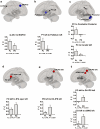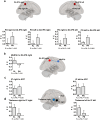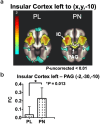Functional connectivity associated with attention networks differs among subgroups of fibromyalgia patients: an observational case-control study
- PMID: 38702506
- PMCID: PMC11068894
- DOI: 10.1038/s41598-024-60993-9
Functional connectivity associated with attention networks differs among subgroups of fibromyalgia patients: an observational case-control study
Abstract
Fibromyalgia is a heterogenous chronic pain disorder diagnosed by symptom-based criteria. The aim of this study was to clarify different pathophysiological characteristics between subgroups of patients with fibromyalgia. We identified subgroups with distinct pain thresholds: those with a low pressure pain threshold (PL; 16 patients) and those with a normal pressure pain threshold (PN; 15 patients). Both groups experienced severe pain. We performed resting-state functional MRI analysis and detected 11 functional connectivity pairs among all 164 ROIs with distinct difference between the two groups (p < 0.001). The most distinctive one was that the PN group had significantly higher functional connectivity between the secondary somatosensory area and the dorsal attention network (p < 0.0001). Then, we investigated the transmission pathway of pain stimuli. Functional connectivity of the thalamus to the insular cortex was significantly higher in the PL group (p < 0.01 - 0.05). These results suggest that endogenous pain driven by top-down signals via the dorsal attention network may contribute to pain sensation in a subgroup of fibromyalgia patients with a normal pain threshold. Besides, external pain driven by bottom-up signals via the spinothalamic tract may contribute to pain sensations in another group of patients with a low pain threshold. Trial registration: UMIN000037712.
© 2024. The Author(s).
Conflict of interest statement
The authors declare no competing interests.
Figures




Similar articles
-
Altered fMRI resting-state connectivity in individuals with fibromyalgia on acute pain stimulation.Eur J Pain. 2016 Aug;20(7):1079-89. doi: 10.1002/ejp.832. Epub 2016 Jan 15. Eur J Pain. 2016. PMID: 26773435
-
The contribution of sensory system functional connectivity reduction to clinical pain in fibromyalgia.Pain. 2014 Aug;155(8):1492-1503. doi: 10.1016/j.pain.2014.04.028. Epub 2014 May 2. Pain. 2014. PMID: 24792477
-
Fibromyalgia is associated with decreased connectivity between pain- and sensorimotor brain areas.Brain Connect. 2014 Oct;4(8):587-94. doi: 10.1089/brain.2014.0274. Epub 2014 Aug 7. Brain Connect. 2014. PMID: 24998297 Free PMC article.
-
Disrupted functional connectivity of the pain network in fibromyalgia.Psychosom Med. 2012 Jan;74(1):55-62. doi: 10.1097/PSY.0b013e3182408f04. Epub 2011 Dec 30. Psychosom Med. 2012. PMID: 22210242
-
Cold Water Pressor Test Differentially Modulates Functional Network Connectivity in Fibromyalgia Patients Compared with Healthy Controls.Annu Int Conf IEEE Eng Med Biol Soc. 2018 Jul;2018:578-582. doi: 10.1109/EMBC.2018.8512350. Annu Int Conf IEEE Eng Med Biol Soc. 2018. PMID: 30440463 Free PMC article.
Cited by
-
Quantitative Sensory Testing in Fibromyalgia Syndrome: A Scoping Review.Biomedicines. 2025 Apr 17;13(4):988. doi: 10.3390/biomedicines13040988. Biomedicines. 2025. PMID: 40299678 Free PMC article. Review.
-
The Casual Associations Between Brain Functional Networks and Fibromyalgia: A Large-Scale Genetic Correlation and Mendelian Randomization Study.Bioengineering (Basel). 2025 Jun 25;12(7):692. doi: 10.3390/bioengineering12070692. Bioengineering (Basel). 2025. PMID: 40722384 Free PMC article.
References
Publication types
MeSH terms
Grants and funding
LinkOut - more resources
Full Text Sources
Medical

